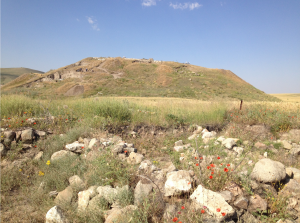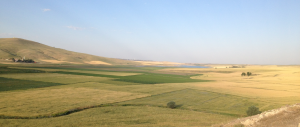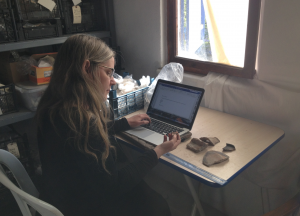
EXPERIENCING THE MIDDLE BYZANTINE COUNTRYSIDE AT ÇADIR HOYUK
Tasha Vorderstrasse, 2017 Strange/Midkiff Excavation Fellowship Recipient

View of Çadır Höyük. Note the Middle Byzantine fortification wall including the remains of a tower, at the top of the mound.
Thanks to the generosity of the ASOR Strange/Midkiff Fellowship, I am able to go to Turkey to participate in the excavations at the sites of Çadır Höyük and Komana. My first stop was the site of Çadır Höyük, doubtless familiar to many of you who attend the ASOR annual meetings and have read their many publications. Çadır Höyük, which is excavated under the leadership of Dr. Gregory McMahon (Project Director) of the University of New Hampshire and Dr. Sharon Steadman of SUNY Cortland (Field Director and Project Co-Director), is located in central Turkey, about a 3 -hour bus ride from Ankara. Although it is not a large site in terms of size, it has a great variety of material from different phases of Turkey’s archaeological history and therefore is an important site. I was working with Dr. Marica Cassis of Memorial University of Newfoundland on the medieval pottery at the site. I am publishing the medieval pottery from the nearby site of Alishar Hüyük that was excavated by the Oriental Institute of the University of Chicago from 1927-1932 and the Çadır pottery is a valuable comparanda to both the Alishar and Komana materials. I would like to thank the team at Çadır Höyük for the opportunity to look at the pottery at the site. Everyone there was so generous with their time and very welcoming.
The reason I came to see the site is to look at the evidence for the latest phase of occupation: Middle Byzantine/Seljuk (10th-12th century). This is a pivotal moment in the history of medieval Anatolia after the Seljuk Turks defeated the Byzantines in 1071, taking over much of what is now modern Turkey. But while we have a lot of information about this period in the historical sources, identifying this period in the archaeological record, particularly in the countryside, remains problematic. The question of what influences the invading Seljuks and other groups had on the material culture of the rural areas is a question that has so far largely been neglected by specialists, with most of the attention concentrating on the fine art of elite urban centers. Indeed, the medieval Anatolian countryside in general still largely remains unstudied.

View of the plain below the mound. The position of Çadır Höyük on the plain would allow the population on the mound to see whoever was coming into the region.
Nevertheless, the topic of the medieval countryside is far more interesting than the previous amount of work on it would suggest. Identifying how the material culture of populations changed (or did not) through time and how this could reflect the changing identity of the population, has been a topic of interest of mine for a long time. While the countryside is often seen as being a backwater compared to urban centers, finds at medieval rural settlements suggest that the populations were not isolated and cut off from other rural settlements or from their urban neighbors. Rather, they formed part of a complex system of settlements that interacted with each other and formed key parts of settlement networks. But it is these relationships that we are now only starting to understand. When working at these medieval sites, it can be a complicated process to even date the pottery, due to the lack of published parallels.
The material from Çadır Höyük represents a great opportunity to study this period and my visit so far to Çadır Höyük has been very useful in terms of starting to better understand this sequence which will allow me to see how this site fits into what we know from the nearby site of Alishar as well as the site of Komana located about three hours of here near Tokat, where I am now. Stay tuned and you will read all about Komana and my work there in my subsequent blog post.
For more on the site of Çadır Höyük, see their webpage: http://www.cadirhoyuk.com
Dr. Tasha Vorderstrasse is a Research Associate at the Oriental Institute of the University of Chicago. She works on the archaeology of the Near East, the Caucasus and Central Asia and the connections between those regions and China.
